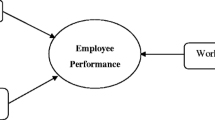Abstract
This study examines the effects that a manager's formal education, on-the-job training, race and gender had on the probability of being promoted from different jobs during his or her career in a company. Having a bachelor's degree with a major in business or engineering had significant screening effects on the probability of being promoted. The education screening was much stronger for low performing managers than for high performers. There was no evidence of gender or race or race discrimination effects. The importance of determining screening variables is discussed.
Similar content being viewed by others
References
Beehr, T., Taber, T.D., & Walsh, J.T., (1980). Perceived mobility channels: Criteria for intra-organizational mobility.Organizational Behavior & Human Performance, 26, 250–264.
Cox, D.R. (1972). Regressions models and life tables.Journal of Royal Statistical Society, B(34), 187–202.
Doeringer, P., & Piore, M. (1971).Internal labor markets and manpower analysis. Lexington, MA: Heath-Lexington Books.
Harrell, F.E. (1990).Survival and Risk Analysis. American Statistical Association Continuing Education Program, Durham, NC: Duke University Medical Center.
Hintze, J.L. (1989).SOLO Statistical system: Version 3.0 Survival Analysis [Computer program]. Los Angeles: BMDP Statistical Software, Inc.
Markham, W.T., Harlan, S.L., & Hackett, E.J. (1987). Promotion opportunity in organizations: Causes and consequences. In K.M. Rowland and G.R. Ferris (Eds.),Research in Personnel and Human Resources Management (pp. 223–287). Greenwich, CT: JAI Press.
Peters, L.H., & Sheridan, J.E. (1988). Turnover research methodology: A critique of traditional designs and a suggested survival model alternative. In K.M. Rowland & G.R. Ferris (Eds.),Research in personnel and human resource management (Vol. 6). (pp. 231–262). Greenwich, CT: JAI Press.
Rosenbaum, J.E. (1984).Career Mobility in a Corporate Hierarchy. Orlando, FL: Academic Press.
Sheridan, J.E., Slocum, J.W., Jr., Buda, R., & Thompson, R. (1990). Effects of corporate sponsorship and departmental power on career tournaments.Academy of Management Journal, 33, 578–602.
Strober, M.H. (1990). Human capital theory: Implications for HR managers.Industrial Relations, 29(2), 214–239.
Thurow, L.C. (1972). Education and economic equality.The Public Interest, 28, 66–81.
Author information
Authors and Affiliations
Additional information
Support for this research was provided by the participating company and the Cox School of Business, Southern Methodist University. The authors acknowledge the helpful comments on earlier drafts of this manuscript by Professors Joan Brett, Jack Brittain, Ellen Jackofsky, Barbara Lawrence, and Robin Pinkley.
Rights and permissions
About this article
Cite this article
Sheridan, J.E., Slocum, J.W. & Buda, R. Factors influencing the probability of employee promotions: A comparative analysis of human capital, organization screening and gender/race discrimination theories. J Bus Psychol 11, 373–380 (1997). https://doi.org/10.1007/BF02195900
Issue Date:
DOI: https://doi.org/10.1007/BF02195900




